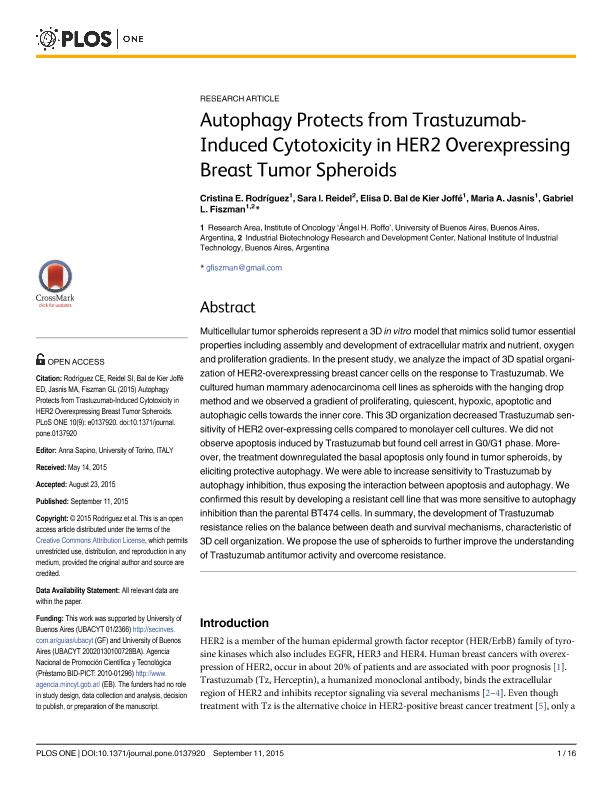Mostrar el registro sencillo del ítem
dc.contributor.author
Rodríguez, Cristina Elisa

dc.contributor.author
Reidel, Sara I.
dc.contributor.author
Bal, Elisa Dora

dc.contributor.author
Jasnis, Maria Adela

dc.contributor.author
Fiszman, Gabriel Leon

dc.date.available
2018-03-14T22:02:49Z
dc.date.issued
2015-09
dc.identifier.citation
Rodríguez, Cristina Elisa; Reidel, Sara I.; Bal, Elisa Dora; Jasnis, Maria Adela; Fiszman, Gabriel Leon; Autophagy protects from trastuzumab-induced cytotoxicity in HER2 overexpressing breast tumor spheroids; Public Library of Science; Plos One; 10; 9; 9-2015; 1-16; e0137920
dc.identifier.issn
1932-6203
dc.identifier.uri
http://hdl.handle.net/11336/38850
dc.description.abstract
Multicellular tumor spheroids represent a 3D in vitro model that mimics solid tumor essential properties including assembly and development of extracellular matrix and nutrient, oxygen and proliferation gradients. In the present study, we analyze the impact of 3D spatial organization of HER2-overexpressing breast cancer cells on the response to Trastuzumab. We cultured human mammary adenocarcinoma cell lines as spheroids with the hanging drop method and we observed a gradient of proliferating, quiescent, hypoxic, apoptotic and autophagic cells towards the inner core. This 3D organization decreased Trastuzumab sensitivity of HER2 over-expressing cells compared to monolayer cell cultures. We did not observe apoptosis induced by Trastuzumab but found cell arrest in G0/G1 phase. Moreover, the treatment downregulated the basal apoptosis only found in tumor spheroids, by eliciting protective autophagy. We were able to increase sensitivity to Trastuzumab by autophagy inhibition, thus exposing the interaction between apoptosis and autophagy. We confirmed this result by developing a resistant cell line that was more sensitive to autophagy inhibition than the parental BT474 cells. In summary, the development of Trastuzumab resistance relies on the balance between death and survival mechanisms, characteristic of 3D cell organization. We propose the use of spheroids to further improve the understanding of Trastuzumab antitumor activity and overcome resistance.
dc.format
application/pdf
dc.language.iso
eng
dc.publisher
Public Library of Science

dc.rights
info:eu-repo/semantics/openAccess
dc.rights.uri
https://creativecommons.org/licenses/by/2.5/ar/
dc.subject
Autophagy
dc.subject
Trastuzumab
dc.subject
Her2 Breast Cancer
dc.subject
Tumor Spheroids
dc.subject.classification
Otras Biotecnologías de la Salud

dc.subject.classification
Biotecnología de la Salud

dc.subject.classification
CIENCIAS MÉDICAS Y DE LA SALUD

dc.title
Autophagy protects from trastuzumab-induced cytotoxicity in HER2 overexpressing breast tumor spheroids
dc.type
info:eu-repo/semantics/article
dc.type
info:ar-repo/semantics/artículo
dc.type
info:eu-repo/semantics/publishedVersion
dc.date.updated
2018-03-13T18:13:23Z
dc.journal.volume
10
dc.journal.number
9
dc.journal.pagination
1-16; e0137920
dc.journal.pais
Estados Unidos

dc.journal.ciudad
San Francisco
dc.description.fil
Fil: Rodríguez, Cristina Elisa. Universidad de Buenos Aires. Facultad de Medicina. Instituto de Oncología "Ángel H. Roffo"; Argentina
dc.description.fil
Fil: Reidel, Sara I.. Instituto Nacional de Tecnología Industrial. Centro de Investigación y Desarrollo en Biotecnología Industrial; Argentina
dc.description.fil
Fil: Bal, Elisa Dora. Universidad de Buenos Aires. Facultad de Medicina. Instituto de Oncología "Ángel H. Roffo"; Argentina. Consejo Nacional de Investigaciones Científicas y Técnicas; Argentina
dc.description.fil
Fil: Jasnis, Maria Adela. Universidad de Buenos Aires. Facultad de Medicina. Instituto de Oncología "Ángel H. Roffo"; Argentina
dc.description.fil
Fil: Fiszman, Gabriel Leon. Instituto Nacional de Tecnología Industrial. Centro de Investigación y Desarrollo en Biotecnología Industrial; Argentina. Universidad de Buenos Aires. Facultad de Medicina. Instituto de Oncología "Ángel H. Roffo"; Argentina
dc.journal.title
Plos One

dc.relation.alternativeid
info:eu-repo/semantics/altIdentifier/doi/http://dx.doi.org/10.1371/journal.pone.0137920
dc.relation.alternativeid
info:eu-repo/semantics/altIdentifier/url/http://journals.plos.org/plosone/article?id=10.1371/journal.pone.0137920
Archivos asociados
